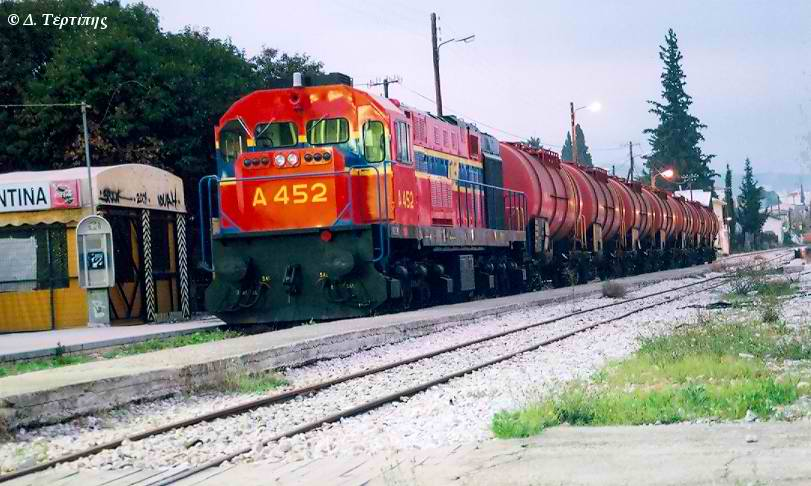|
Hellenic Locomotive highlightsBusiness report: rolling stock operations on Axis 22While it is understandable that most rolling stock conforming to the track and loading gauges along the specific corridor can run on it, for the scope of this report we shall concentrate on revenue- earning rolling stock known to be allocated on depots serving Axis 22. From South to North, the following situation concerning rolling stock is encountered: GREECE:The only present mainline operator, state-owned TrainOSE, owns no rolling stock, but hires it from ex-parent entity Chemins de Fer Helleniques (CH s.a.) and occasionally from others (e.g. BDZ) as required. This was also the case with the formerly independent commuter subsidiary PROASTIAKOS S.A. (amalgamated 2007 as an additional TrainOSE Division). The Main Works Division of CH s.a. provides general overhaul facilities in Piraeus and Salonika Workshops, while running sheds for light maintenance are partly staffed by TrainOSE itself. Facilities exist at Piraeus-Rentis (K.P. 6), Lianokladi (K.P 222), Larissa (K.P ___) and Salonica (K.P. 516), while potential additional locations for fueling and/ or temporary stabling could be accommodated at Oinoe(K.P. 71), Tithorea (K.P. ___) and Promachon (K.P. ___) , should demands arise. Up to now, rolling stock maintenance has been erratic. It is based rather on cannibalization than on systematic subsystem replacement and repair, there seems to be little coordination between spare-part supply and operational demands. The separation between infrastructure and operations didn't bring any improvements to rolling stock management. The rolling stock owner did not develop any business-oriented rolling stock subsidiary (nor for that matter any other technical support services aiming at an open market, despite considerable existing know-how) as the case should have been. Although theoretically it cannot monopolize the sector, none of the hitherto created national operating entities TrainOSE and ex-PROASTIAKOS have exercised their rights to challenge the rolling stock status quo by seeking alternative rolling stock solutions outside the parent state agency. Apart from the state railway-owned workshops however, there is some potential for rolling stock services in Greece in the form of independent rolling stock industries, having constructed vehicles for both the domestic and international market. One of these suppliers, strategically placed in Eleusis, with direct access to both standard and meter gauge networks is the Eleusis Shipyard s.a. Leading executives of their rail vehicle department have expressed interest to provide heavy maintenance services to potential private operators outside the moribund and unpredictable TrainOSE. Given the general anti-rail policy, there are concerns that significant portions of the state-owned rolling stock may be forcibly directed towards scrapping instead of exhausting every effort to utilize it for maximizing its environmental and economic benefits to the taxpayers that paid for it. MOTIVE POWER HIGHLIGHTS ALONG AXIS 22:
5 pieces refurbished for light freight and shunting duties.
| |||||||||||||||||||||||||||||||||||||||||||||||||||||||||||||
|
|
 SBAROUNIS & ASSOCIATES TRANSPORT INFO & CONSULTANCY
SBAROUNIS & ASSOCIATES TRANSPORT INFO & CONSULTANCY A 451 – 470,
A 451 – 470,  A
501 – 510 (MX636),
A
501 – 510 (MX636), 
 ALCo
DL532B,Bo'Bo'de, 1961, 1050PS
ALCo
DL532B,Bo'Bo'de, 1961, 1050PS
 FAUR
LDH70 diesel shunters (class A-151), B'B'dh divided into 2
sub-classes of 700 & 750 PS respectively. Motors by Mercedes-
Benz. They 've been supplemented in recent years by 2nd-hand sister
locos imported from ex-socialist countries by contractors for work
trains. This loco family is uniquely universal in all countries
served by Axis 22. Seen at the main Depot at Rentis (Piraeus) by K.
Krallis.
FAUR
LDH70 diesel shunters (class A-151), B'B'dh divided into 2
sub-classes of 700 & 750 PS respectively. Motors by Mercedes-
Benz. They 've been supplemented in recent years by 2nd-hand sister
locos imported from ex-socialist countries by contractors for work
trains. This loco family is uniquely universal in all countries
served by Axis 22. Seen at the main Depot at Rentis (Piraeus) by K.
Krallis.

 Very
few of the depicted
Very
few of the depicted 